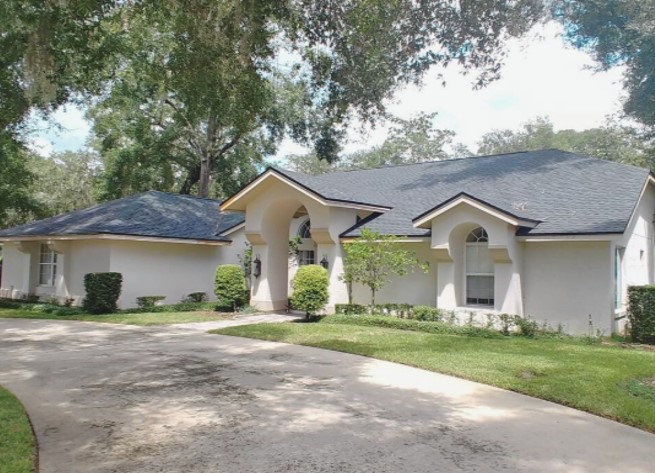Odili Donald Odita, abstract painter and professor of painting at Philadelphia’s Temple University, talks Tuesday about his mural, “Surround,” in the lobby of the University of Iowa Stanley Museum of Art, 160 W. Burlington St., in Iowa City. The museum will house the university’s art collection, including Jackson Pollock’s “Mural.” (Jim Slosiarek/The Gazette)
Odili Donald Odita, abstract painter and professor of painting at Philadelphia’s Temple University, talks Tuesday about his mural, “Surround,” in the lobby of the University of Iowa’s new Stanley Museum of Art, 160 W. Burlington St., in Iowa City. (Jim Slosiarek/The Gazette)
Jenna Pirello touches up spots along a line dividing two colors as work continues Tuesday on the mural “Surrounding” in the lobby of the University of Iowa Stanley Museum of Art. (Jim Slosiarek/The Gazette)
Conor Fields removes tape masking one color from another Tuesday as he and Jenna Pirello and Alan Prazniak (both not pictured) help paint the mural “Surrounding” in the lobby of the University of Iowa Stanley Museum of Art in Iowa City. (Jim Slosiarek/The Gazette)
Alan Prazniak (left) steps off a ladder Tuesday as he and Conor Fields and Jenna Pirello (not pictured) work on painting the mural “Surrounding” in the lobby of the University of Iowa Stanley Museum of Art, 160 W. Burlington St., in Iowa City. (Jim Slosiarek/The Gazette)
IOWA CITY — When the University of Iowa Stanley Museum of Art opens Aug. 26, Jackson Pollock’s “Mural” won’t be the first mural visitors see. Odili Donald Odita’s “Surrounding” will be.
The UI museum’s 8-by-20-foot Pollock star attraction will have its own gallery on the second floor, while Odita’s even larger 13.5–by-27-foot creation will be visible through soaring floor-to-ceiling windows before visitors even step into the first-floor lobby, which is dubbed “Thresholds.”
And what a splash it will make. With bold geometric designs flowing and crashing into each other, the entire wall already is taking shape with bright magentas, yellows, pinks, blues, greens, oranges and aquas hand-mixed from acrylic latex wall paint, so no two hues will ever be alike in Odita’s projects.
It’s full of lively visual movement, perfectly illustrating his “kaleidoscopic” signature style, as well as his mission to explore color in historical and sociopolitical realms.
“I might use different blues or different reds in the work,” Odita, 56, of Philadelphia, said during a media event this week. “For me, it’s important to have that specificity, because people are not just one color or one type of being. There are many types of being.
“So when I’m looking and thinking of that different blues, I want one to be able to not just say blue, blue, blue, blue, blue but blue-orange or purple blue, green-blue, green, blue-yellow. Be able to just look at the colors and start to engage them for the specificity and for their sense of space.
“And that becomes part of the way of constructing this thought process where I’m an African artist, an artist of color — and maybe if we think about people in the world, the Black person in the world, we might not just say, ‘Black person, Black person, Black person, Black person,’ but ‘this person here and that person there; this person with the suit; this person with the children.’ To be able to get to be more specific and (have) more actually real identifications, versus just stereotype.”
At a glance
What: University of Iowa Stanley Museum of Art
Where: 160 W. Burlington St., Iowa City
Size: 63,000 square feet, including more than 16,500 square feet of exhibition space and 2,200 square feet of outdoor gallery space
Building cost: $50 million
Architect: BNIM Iowa, Rod Kruse, lead
Opening: Aug. 26, with ribbon cutting at 3 p.m., followed by three bands and gallery tours; Aug. 27, family activities, gallery tours, art-making activities in Gibson Square Park, and Cedar Rapids Opera performances from “The Grant Wood Operas: Strokes of Genius“ 2019 commissions; Aug. 28, more family activities; watch for updates online
Public hours: 10 a.m. to 4:30 p.m. Tuesday to Saturday; noon to 4:30 p.m. Sunday; closed Monday
Admission: Free
Details: stanleymuseum.uiowa.edu/
“As soon as I learned about his work, I knew he was the perfect artist to kick off this series of installations of public art in our lobby, which we’re calling ‘Thresholds,’ ” said museum Director Lauren Lessing.
“But really seeing it come to come together on the wall? I can’t wait to get to work every morning because every day it’s a little bit different. I’ve been really enjoying students, members of the public kind of gathering on our terrace and peeking through the windows.”
About the artist
Odita, an abstract artist and professor of painting at Temple University in Philadelphia, is spending two weeks at the museum creating this initial offering in a series of public installations showcasing the work of artists with deep Iowa ties. His assistants — Alan Prazniak, Conor Fields and Jenna Pirello — came to Iowa City to help with the installation.
Born in Enugu, Nigeria, in 1966, Odita was just 6 months old when his family fled their homeland at the start of the Biafran War.
His parents had studied at the UI before he was born, returned to Nigeria, then came back to Iowa City after he was born. Here, his father studied printmaking and his mother studied social research.
The couple finished their graduate work at Indiana University in Bloomington before settling in Columbus, Ohio, where Odita’s father founded the African Art History Department at Ohio State University. Odita earned his bachelor’s of fine arts degree there in 1988, then completed his master’s of fine arts degree at Bennington College in Vermont in 1990, majoring in painting and minoring in printmaking and drawing.
He was surrounded by art growing up, from the African art and his father’s paintings hanging on the walls, to books on the Renaissance and Picasso. Still, he gravitated toward drawing and comic books, and later fashion, with his earliest art-making memories reaching back to age 5. He’s been on an artistic journey ever since, combining education with his own work, exhibited at home and abroad.
“It’s surprising how much influence things around you put into you as you’re growing,” Odita said. “So I think back on all of that stuff that I looked at, and it’s just interesting how it comes out.”
Public art
Odita has returned to Iowa City several times over the years, and now is leaving his mark at the new museum for at least a few years, after which museum officials said the space might be reused to feature another artist’s work.
“One of the challenges of having this beautiful space with so much glass and so many windows is that sunlight pours in, and that’s not so good for pigment,” Lessing said. “Works that are made in color break down over a period of years. So we really can’t bring work from our collection — not much of it out in this space.
“But we want this to be an art-filled space. We want this to be a place where people know right away that we’re an art museum. And so that was a challenge that we decided to meet with works of public art. They will come and go over the years, and that’s part of what will animate this space. After a few years, we might reuse that wall for another work.”
The next piece in the “Thresholds” series won’t displace Odita’s mural, Lessing noted. Instead, it will be installed during the museum’s second year, in the Light Well — a soaring three-story space in the middle of the lobby that opens to the sky. The only detail revealed about the upcoming piece is that it’s intended to dissolve.
“It’s really experimental, so we’ll see it change over the year that it’s installed. And it could look a lot of different ways,” Lessing said. “But one of the really wonderful things about being a university art museum is that we can experiment.”
New dimensions
The new building is “fantastic,” Odita declared. “It’s typical of a lot of structures you see, you think maybe it’s just not that big. Then you’re like, ‘Oh, my God, it’s huge.’ ”
The second floor houses the galleries, with cases for exhibiting specific collections, like ceramics, but also for storing some of the 20,000 pieces in the museum’s collection. The third floor houses classrooms and teaching spaces, as well as two outdoor terraces with sweeping views of downtown Iowa City.
Many of the second-floor walls can be moved into other configurations to best accommodate exhibitions. The galleries are open enough that they don’t create a maze, but visitors will have to turn a corner to find Pollock’s “Mural.” That’s intentional, Lessing said, “creating a sense of surprise as you come in.”
Having “Mural” return after being away since the 2008 flood goes beyond the visual impact for visitors, and into the teachable realm for students.
With this landmark work, created in 1943, Pollock “really launched himself out into space and did something totally new, and I love that we have that moment of epiphany, that moment of innovation, because that’s what we want to teach,” Lessing said. “We want to teach students to do that. To take risks, to innovate, to be creative, to trust themselves and to really step outside the comfort zone (and) step into the unknown.
“We are kind of a portal that leads to the rest of the world — to the bigger world — and we hope that students come into this museum and really stretch themselves and leave all full of creative ideas.”
Comments: (319) 368-8508; [email protected]








